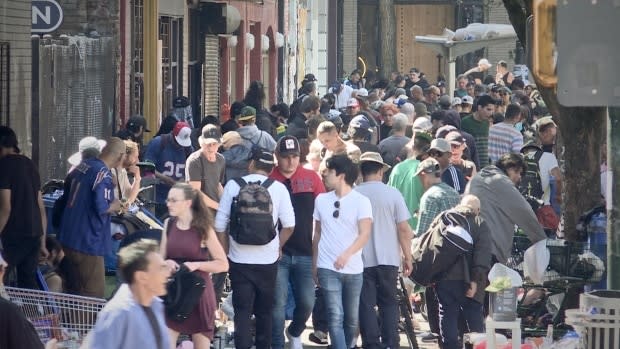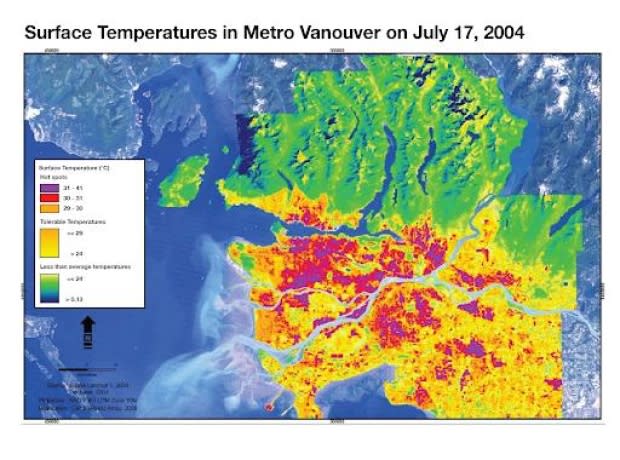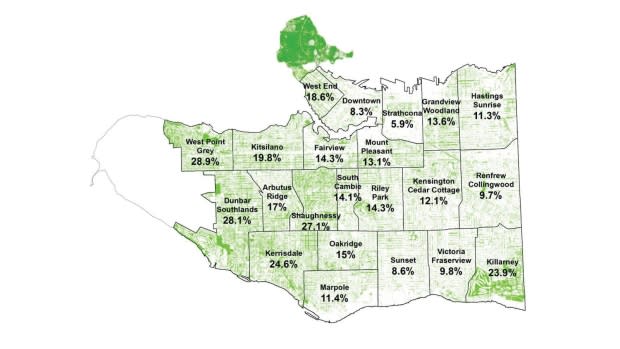Vancouver's Downtown Eastside can get dangerously hot; the answer is more trees
During the summer, Metro Vancouver is like a bad microwave. Not everything heats up evenly.
The land in more developed areas such as downtown Vancouver or near SkyTrain stations in Richmond, Burnaby and Surrey is significantly hotter than in more suburban areas like Langley or Maple Ridge — by up to 17 C in some cases!
The reason behind that is a phenomenon known as the urban heat island effect.
As cities develop, they tend to trap and produce more heat. Surfaces like asphalt, concrete and glass are like sponges for heat from solar radiation. There's also the exhaust in the air from vehicle traffic and waste heat from air-conditioners.
Even the grid-layout of Vancouver causes light to bounce back and forth from building to building, trapping more heat.
Cities lack the greenery of more natural environments and that causes them to miss out on a natural cooling process called evapotranspiration.
The combination of dirt, trees and plants soak up water during rainy days and release it back into the air during hot days as water vapour, cooling the air around them. Concrete and asphalt don't do that.

So how do we bring back the balance? There are upcoming solutions like green roofs or even reflective paints that aim to reduce the urban heat island effect.
But I'd like to offer a less flashy solution with a proven track record: trees.
Vancouver's West End is a great example of this. Trees cover 18.6 per cent of the land in the West End and, as a result, its surface temperatures are closer to that of Langley or Delta.

For most of us, the urban heat island effect is probably more of an inconvenience than anything. But that extra heat can be a serious issue in a neighbourhood like the Downtown Eastside.
For starters, trees cover just six per cent of the land, and that results in a lot of heat. According to the City of Vancouver's urban forest master strategy, surface temperatures there can measure 42 C to 49 C on a hot day.
But the real concern is that is that we have an especially vulnerable homeless community in the Downtown Eastside. People that might not have reliable access to air-conditioned shelter or water are especially at risk during a hot day. In 2009, a heat wave took the life of a homeless man in Vancouver.

The City of Vancouver is currently on track to plant 150,000 trees by the year 2020. The plan began in 2010 and was outlined in the city's Urban Forest Strategy. At the time of publishing, the city's website states that almost 126,000 trees have been planted so far.
However, the data suggests that the Downtown Eastside has seen much less of this increase. I analyzed the City of Vancouver's database of street trees planted between 2010 and 2014 and, out of 9,600 trees planted in that time, just 78 of them were planted in the Downtown Eastside.

With that being said, the City of Vancouver has prioritized that neighbourhood in its 2018 update to the Urban Forest Strategy, with a goal to double the tree cover in there by 2030.
There are many critical issues affecting the Downtown Eastside and I am certainly not proposing that trees are going to solve everything — far from it.
But when it comes to temperature, I think initiatives like this will go a long way to sheltering this community from some of the worst heat waves that hit us in the summer.
This column is part of CBC's Opinion section. For more information about this section, please read our FAQ.
Listen to the full column for The Early Edition here:


